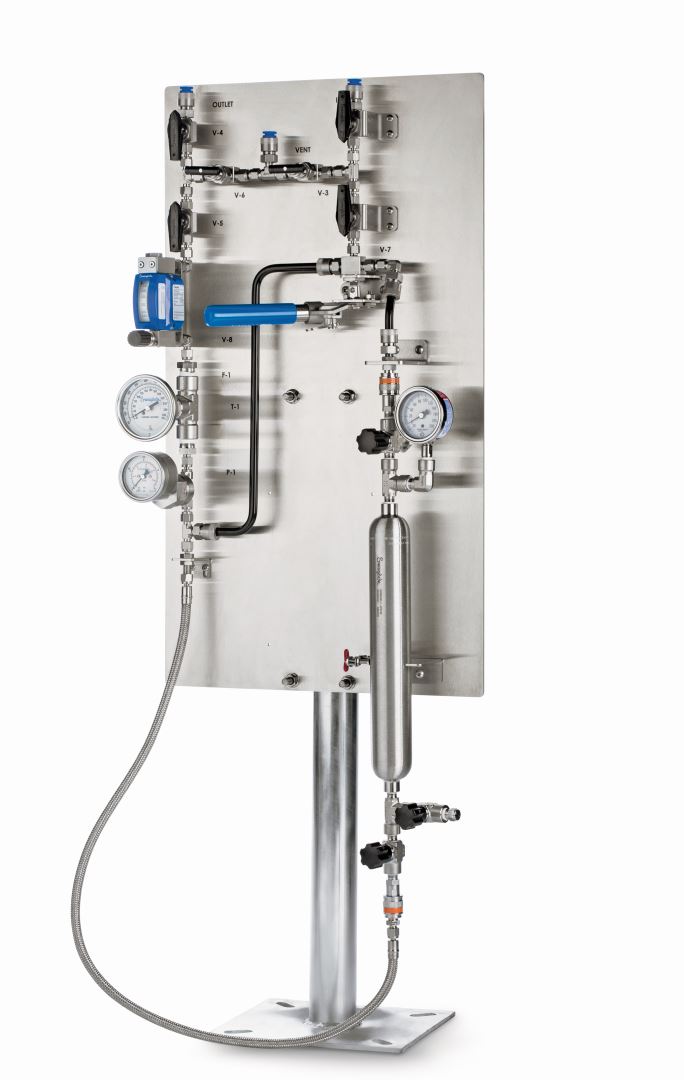Share this
Critical Industrial Fluid Management Guidelines for SAGD Operations to Keep in Mind
by Tristian McCallion on Tue, Aug 03, 2021 @ 11:08 AM

SAGD products must have precise chemical compositions based on customer specifications, government regulations, and other industrial fluid management guidelines. Managing these composition requirements calls for regular sampling and analysis of the process fluid.
Sample analysis is only useful, however, if samples are collected from well-designed, properly installed sampling systems using good operating practices. In this post, we’ll look at some industrial fluid management guidelines for SAGD fluid systems and how proper sampling system design and best operating practices can help ensure safe, reliable operations.
Fluid System Challenges in SAGD Operations
SAGD operations depend on rotating equipment like emulsion well pads, boiler feed pumps, water treatment pumps, and export pumps—and, seal flush systems are critical to their functioning. When a seal or flush system fails, the system must be shut down until the cause is determined and addressed. If onsite engineers can’t identify the cause of the problem, unplanned downtime can become a major problem.
Seal flush systems must be able to withstand the harsh fluid conditions of SAGD to optimize fluid management and prevent seal failures. When an issue arises during SAGD operations in remote locations, timely containment and corrective action are critical. Below are a few of the most common fluid system challenges in SAGD operations.
- Clogged Seals or Orifices: Because SAGD operations process high viscosity, heavy crude oil, flow issues are common. Heavy crude contains solids that can obstruct flow to the sampling station, making it difficult to get a representative sample. A clog obstructing flow to the seal chamber can lead to seal damage or failure.
- Leaks in Connections: Inboard, outboard, and internal leaks are often the result of improper installation—for example, not fully inserting tubing, under- or over-tightening connections, or putting bends too close to the end of the tube. Leaks can also occur when piping or tubing has surface defects like dents or scratches, when components are not rated for the process conditions, or when using low-quality components.
- Changes in Fluid Characterization: As the composition and water content of SAGD process fluid changes over time, its ability to flush and cool the seal can diminish. Understanding these changes in fluid characterization is essential to ensuring safe, reliable functioning. Regular sampling and analysis—using a well-mixed, representative sample—can tell you when process parameters like pump pressure or line size need to be adjusted.
Industrial Fluid Management Guidelines for Grab Sampling System Design
When designing a grab sampling station, there are countless options and configurations to choose from. Good design choices depend on the details of the application. Below are some important factors to consider.
- System Pressure and Temperature: All components of the grab sampling system must be rated for the maximum pressure and temperature of the fluid system.
- Hazardous Fluids: The system must protect the operator and the environment from hazardous process fluids. Some chemicals require specific leak prevention measures.
- Construction Materials: The materials used in the grab sampling system must be compatible with the process fluid. Corrosion-resistant alloys may be required.
- Surface Treatments: Certain surface treatments can reduce absorption and adsorption of the sample fluid into metallic surfaces, preventing contamination and allowing a more representative sample.
- Purge Option: Some process chemicals leave residue or contamination if they are not flushed from the sampling line. A purge option allows thorough flushing of the sampling line to ensure a clean, representative sample.
A well-designed grab sampling station includes all features mounted on a single panel, including a geared valve assembly for ease of use, quick-connect couplings for repeatable connections, a flexible connection hose, a pressure gauge, and cylinder support (if using sample cylinders).
Best Operating Practices for Collecting Samples
Samples must be as representative of the process conditions as possible. A sample must be fully mixed in the process line and cannot be contaminated during or after sampling. These guidelines will help you ensure your samples are clean and representative of the process.
Use the Right Container
After collecting a sample, it is important to use a container that can maintain the sample as close to process conditions as possible. Sample cylinders are required for gases or volatile liquids to prevent evaporation and fractionation. Bottles can be used if the sample is an unpressurized, non-volatile, non-toxic liquid.
Avoid Contamination
Purge the line and container before sampling. Collect the sample with a smooth bore, not a corrugated hose. Analyze the sample as soon as possible to minimize the risk of contamination.
Avoid Phase Changes
Evaporation or condensation in the sampling line will alter the composition of the sample so it is not representative of the process. Avoid phase changes by maintaining adequate pressure and temperature during collection. Consult the P-T diagram of the fluid to understand the pressure and temperature needed to prevent phase changes. Never sample a fluid close to its phase change point.
Sample from the Right Location
Draw the sample from the middle third of the process line. The faster-moving fluid in the centre of the line is more likely to be well-mixed, while the slower-moving fluid near the wall may be less representative. In particular, avoid the bottom of the line where solids can collect.
Avoid Dead Legs
Dead legs are spaces in the system with no flow—tees, pressure gauges, and temperature indicators—where solids and old fluid accumulate. Avoid drawing samples downstream of dead legs, and try to install these components downstream of the sampling station so they won’t affect sample integrity.
Mount Sample Containers Safely
Mount cylinder supports or bottle shrouds and stirrups in grab sampling stations to securely hold vessels in place. This reduces stress on the quick-connect couplings, increasing their service lives and ensuring operator safety.
Don’t Overfill
Whether using a cylinder or bottle, do not fill the sample container beyond 80 percent of its capacity.
Fluid Management Support from Local Experts
Edmonton Valve & Fitting understands the challenges of processing heavy crude oil in Alberta SAGD operations. Whether you need a new sampling system, an upgrade, or support during troubleshooting, we can help. Our Field Advisors can perform a fluid systems evaluation to determine the best solution to improve performance and reliability for your SAGD operation. We also offer fitting kits and specialty fittings and connections to reduce leak points and minimize rotating equipment downtime.
We make grab sampling stations to order right here in Edmonton. We'll be happy to discuss your specific needs so we can help you understand the applicable industrial fluid management guidelines and make the right design choices for your SAGD operation. To help get you started, download the Grab Sampling Systems Application Guide.
About Tristian McCallion, Custom Solutions Manager, Edmonton Valve
 Edmonton Valve has relied on McCallion for 26 years. His current title is Custom Solutions Manager. Earlier, he supervised our sales team. Before that, he managed sales throughout Edmonton and northeastern Alberta. For 12 years he also worked with Swagelok Energy Advisors across North America, training customers on steam fundamentals (TAP), testing steam traps, and conducting steam system audits.
Edmonton Valve has relied on McCallion for 26 years. His current title is Custom Solutions Manager. Earlier, he supervised our sales team. Before that, he managed sales throughout Edmonton and northeastern Alberta. For 12 years he also worked with Swagelok Energy Advisors across North America, training customers on steam fundamentals (TAP), testing steam traps, and conducting steam system audits.
Share this
- Local Services (103)
- Field Advisors (101)
- Training & Events (86)
- Fittings (81)
- Valves (66)
- Resources (62)
- Tubing (62)
- Sampling Systems (60)
- Design & Assembly (57)
- Resources - Downloads (40)
- Hose & Flexible Tubing (39)
- Frequently Asked Questions (37)
- Regulators (34)
- Cost Savings (33)
- Oil & Gas (33)
- Videos (33)
- Steam Systems (29)
- Mechanical Seal Support (17)
- Measurement Devices (15)
- Gas Distribution Systems (9)
- Rentals (6)
- winterization (6)
- Safety (5)
- Covid (3)
- Hydrogen & Clean Energy (3)
- About Us (1)
- April 2024 (3)
- March 2024 (2)
- January 2024 (3)
- December 2023 (2)
- November 2023 (3)
- October 2023 (2)
- September 2023 (3)
- August 2023 (3)
- July 2023 (3)
- June 2023 (2)
- May 2023 (4)
- April 2023 (2)
- March 2023 (2)
- February 2023 (3)
- January 2023 (2)
- December 2022 (1)
- November 2022 (1)
- October 2022 (2)
- September 2022 (5)
- August 2022 (3)
- July 2022 (6)
- June 2022 (4)
- May 2022 (3)
- April 2022 (1)
- March 2022 (2)
- February 2022 (3)
- January 2022 (4)
- December 2021 (4)
- November 2021 (6)
- October 2021 (3)
- September 2021 (5)
- August 2021 (9)
- July 2021 (5)
- June 2021 (7)
- May 2021 (7)
- April 2021 (4)
- March 2021 (3)
- February 2021 (3)
- January 2021 (2)
- December 2020 (3)
- November 2020 (3)
- October 2020 (2)
- September 2020 (3)
- August 2020 (3)
- July 2020 (3)
- June 2020 (3)
- May 2020 (3)
- April 2020 (2)
- March 2020 (3)
- February 2020 (3)
- January 2020 (3)
- December 2019 (2)
- November 2019 (3)
- October 2019 (3)
- September 2019 (2)
- August 2019 (3)
- July 2019 (2)
- June 2019 (2)
- May 2019 (3)
- April 2019 (3)
- March 2019 (3)
- February 2019 (2)
- January 2019 (3)
- December 2018 (2)
- November 2018 (2)
- October 2018 (4)
- September 2018 (2)
- August 2018 (3)
- July 2018 (3)
- June 2018 (2)
- May 2018 (4)
- April 2018 (3)
- March 2018 (3)
- February 2018 (3)
- January 2018 (4)
- December 2017 (1)
- November 2017 (4)
- October 2017 (4)
- September 2017 (4)
- August 2017 (5)
- July 2017 (3)
- June 2017 (4)
- May 2017 (4)
- April 2017 (3)
- March 2017 (5)
- February 2017 (4)
- January 2017 (4)
- December 2016 (3)
- November 2016 (3)
- October 2016 (4)
- September 2016 (3)
- August 2016 (4)
- July 2016 (2)
- June 2016 (2)
- May 2016 (2)
- April 2016 (4)
- March 2016 (2)
- February 2016 (3)
- January 2016 (4)
- December 2015 (4)
- November 2015 (4)
- October 2015 (5)
- September 2015 (2)
- August 2015 (4)
- July 2015 (5)
- June 2015 (2)
- May 2015 (3)
- April 2015 (5)
- March 2015 (3)
- February 2015 (4)
- January 2015 (3)
- December 2014 (5)
- November 2014 (4)
- October 2014 (4)
- September 2014 (4)
- August 2014 (4)
- July 2014 (5)
- June 2014 (4)
- May 2014 (4)
- April 2014 (5)
- March 2014 (4)
- February 2014 (4)
- January 2014 (4)
- December 2013 (3)
- November 2013 (4)
- October 2013 (5)
- September 2013 (4)
- August 2013 (5)
- July 2013 (4)
- June 2013 (3)
- May 2013 (4)
- April 2013 (5)
- March 2013 (2)
- February 2013 (3)
- January 2013 (5)
- December 2012 (3)
- November 2012 (3)
- October 2012 (5)
- September 2012 (3)
- August 2012 (4)
- July 2012 (4)
- June 2012 (1)



